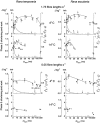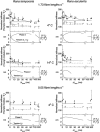Energy transfer during stress relaxation of contracting frog muscle fibres
- PMID: 11744765
- PMCID: PMC2279004
- DOI: 10.1111/j.1469-7793.2001.00923.x
Energy transfer during stress relaxation of contracting frog muscle fibres
Abstract
1. A contracting muscle resists stretching with a force greater than the force it can exert at a constant length, T(o). If the muscle is kept active at the stretched length, the excess tension disappears, at first rapidly and then more slowly (stress relaxation). The present study is concerned with the first, fast tension decay. In particular, it is still debated if and to what extent the fast tension decay after a ramp stretch involves a conservation of the elastic energy stored during stretching into cross-bridge states of higher chemical energy. 2. Single muscle fibres of Rana temporaria and Rana esculenta were subjected to a short ramp stretch (approximately 15 nm per half-sarcomere at either 1.4 or 0.04 sarcomere lengths s(-1)) on the plateau of the force-length relation at temperatures of 4 and 14 degrees C. Immediately after the end of the stretch, or after discrete time intervals of fixed-end contraction and stress relaxation at the stretched length (Delta t(isom) = 0.5-300 ms), the fibre was released against a force ~T(o). Fibre and sarcomere stiffness during the elastic recoil to T(o) (phase 1) and the subsequent transient shortening against T(o) (phase 2), which is expression of the work enhancement by stretch, were measured after different Delta t(isom) and compared with the corresponding fast tension decay during Delta t(isom). 3. The amplitude of fast tension decay is large after the fast stretch, and small or nil after the slow stretch. Two exponential terms are necessary to fit the fast tension decay after the fast stretch at 4 degrees C, whereas one is sufficient in the other cases. The rate constant of the dominant exponential term (0.1-0.2 ms(-1) at 4 degrees C) increases with temperature with a temperature coefficient (Q(10)) of approximately 3. 4. After fast stretch, the fast tension decay during Delta t(isom) is accompanied in both species and at both temperatures by a corresponding increase in the amplitude of phase 2 shortening against T(o) after Delta t(isom): a maximum of approximately 5 nm per half-sarcomere is attained when the fast tension decay is almost complete, i.e. 30 ms after the stretch at 4 degrees C and 10 ms after the stretch at 14 degrees C. After slow stretch, when fast tension decay is small or nil, the increase in phase 2 shortening is negligible. 5. The increase in phase 2 work during fast tension decay (Delta W(out)) is a constant fraction of the elastic energy simultaneously set free by the recoil of the undamped elastic elements. 6. Delta W(out) is accompanied by a decrease in stiffness, indicating that it is not due to a greater number of cross-bridges. 7. It is concluded that, during the fast tension decay following a fast ramp stretch, a transfer of energy occurs from the undamped elastic elements to damped elements within the sarcomeres by a temperature-dependent mechanism with a dominant rate constant consistent with the theory proposed by A. F. Huxley and R. M. Simmons in 1971.
Figures







Similar articles
-
Storage and release of mechanical energy by contracting frog muscle fibres.J Physiol. 1994 Dec 15;481 ( Pt 3)(Pt 3):689-708. doi: 10.1113/jphysiol.1994.sp020474. J Physiol. 1994. PMID: 7707236 Free PMC article.
-
Effect of stretching on undamped elasticity in muscle fibres from Rana temporaria.J Muscle Res Cell Motil. 1999 Jan;20(1):33-43. doi: 10.1023/a:1005460032723. J Muscle Res Cell Motil. 1999. PMID: 10360232
-
Muscle work enhancement by stretch. Passive visco-elasticity or cross-bridges?Adv Exp Med Biol. 1998;453:393-407; discussion 407-9. Adv Exp Med Biol. 1998. PMID: 9889851
-
Muscle Function from Organisms to Molecules.Integr Comp Biol. 2018 Aug 1;58(2):194-206. doi: 10.1093/icb/icy023. Integr Comp Biol. 2018. PMID: 29850810 Review.
-
Do cross-bridges contribute to the tension during stretch of passive muscle?J Muscle Res Cell Motil. 1999 Aug;20(5-6):433-42. doi: 10.1023/a:1005573625675. J Muscle Res Cell Motil. 1999. PMID: 10555062 Review.
Cited by
-
Sarcomere dynamics during muscular contraction and their implications to muscle function.J Muscle Res Cell Motil. 2007;28(1):89-104. doi: 10.1007/s10974-007-9107-8. Epub 2007 May 26. J Muscle Res Cell Motil. 2007. PMID: 17530424 Review.
-
Skeletal muscle resists stretch by rapid binding of the second motor domain of myosin to actin.Proc Natl Acad Sci U S A. 2007 Dec 11;104(50):20114-9. doi: 10.1073/pnas.0707626104. Epub 2007 Dec 6. Proc Natl Acad Sci U S A. 2007. PMID: 18077437 Free PMC article.
-
Elastic energy storage and radial forces in the myofilament lattice depend on sarcomere length.PLoS Comput Biol. 2012;8(11):e1002770. doi: 10.1371/journal.pcbi.1002770. Epub 2012 Nov 15. PLoS Comput Biol. 2012. PMID: 23166482 Free PMC article.
References
Publication types
MeSH terms
LinkOut - more resources
Full Text Sources

